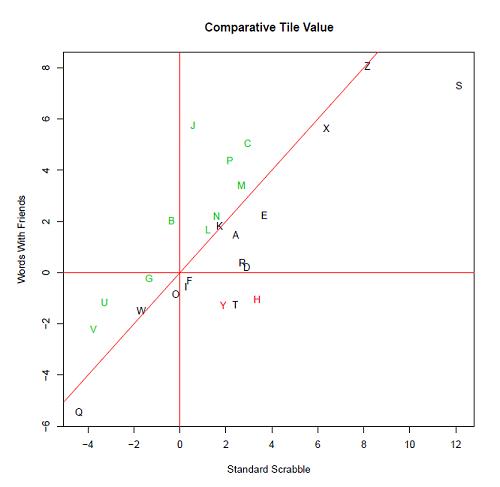Welcome to Purple Pawn, covering games played around the world by billions of people every day.
Scrabble, Words with Friends, and the Real Value of Letter Tiles
26 Jan
Posted by David Miller as Electronic Games, Modern Board Games
Along the way to developing a Scrabble variant meant to reduce the influence of luck from random tile draws, Andrew Thomas, Visiting Assistant Professor in the Carnegie Mellon University Department of Statistics, has managed to figure out the real value of each of those letter tiles (in Scrabble and the derivative online game, Words with Friends), as well as some other very interesting facts.
Prof. Thomas ran computer simulations of both Scrabble and Words with Friends—more than 4 million times each. According to his analysis, the bag (that is, the randomness of tile draws) accounts for 44 percent of a player’s score variance in Scrabble and 34 percent in Words with Friends. The data also shows that going first in Scrabble is worth 14 points to a player’s final score. In Words with Friends the double-word bonus is eliminated, but the first player still enjoys a 10 point advantage.
One factor in the first player advantage is the letter Q. Even though the point value of Q is relatively high (10), the letter is also more difficult to use and interferes with the possibility of getting a bingo (the seven-letter play worth a 50 point bonus in Scrabble or 35 in Words with Friends). In effect, drawing a Q is worth on average -5 points net to a player’s final score. And the first player to draw has a lesser chance of drawing that Q.
Also with an assigned point value of 10 but at the other end of the net value spectrum, is the letter Z, which is worth about 8 points to a player’s final score (in either game). The letter S is worth a lot more in Scrabble, 10 points versus 7 in Words with Friends, largely because of the difference in bingo bonuses. The opposite is true for the letter J—its net value is 6 points in Words with Friends but almost nothing in Scrabble. Blanks are worth about 32 points in Scrabble and 24 in Words with Friends.

[via IEEE Spectrum]
1 Comment
Sorry, the comment form is closed at this time.
Trending
- Massdrop.com
- Oh the Irony—Illuminati Card Game Continues to Inspire Conspiracy Theorists
- Home
- Footprints, an Educational Ecology Game
- USPS Adds Board Game Flat Rate Box
- Baila, the Estonian Drinking Card Game
- Crystal Caste Wins Dice Patent Suit Against Hasbro
- Mirror Game, Red and Blue
- Hasbro and Mattel Merger?
- Are Board Games Dangerous?
Archives
Most Popular Articles
- Oh the Irony—Illuminati Card Game Continues to Inspire Conspiracy Theorists
- The 20 Most Valuable Vintage Board Games
- The Truth About Dominoes On Sunday in Alabama
- Sequence Game, and Variants
- USPS Adds Board Game Flat Rate Box
- Baila, the Estonian Drinking Card Game
- The 13 Most Popular Dice Games
- Are Board Games Dangerous?
- Guess Who? The Naked Version
- What Happened to the Jewel Royale Chess Set?
Recent Posts
- Toy Fair 2019—Breaking Games
- Talisman Kingdom Hearts Edition
- Toy Fair 2019—Winning Moves
- Toy Fair 2019—Games Workshop
- Toy Fair 2019—Star Wars Lightsaber Academy
- Toy Fair 2019—Stranger Things Games
- Toy Fair 2019—HABA
- Licensing Roundup
- Game Bandit
- 2018 A Difficult Year For Hasbro But Not For D&D Or MtG
Recent Comments
- on Toy Fair 2019—Winning Moves
- on Game Bandit
- on Second Look—Dungeons & Dragons Waterdeep Dragon Heist
- on Crowdfunding Highlights
- on Beyblade SlingShock
- on Game Bandit
- on Game Bandit
- on Watch This Game!, the Board Game Review Board Game
- on Second Look—Vampire: The Masquerade 5th Edition
- on Palladium Books Loses Robotech IP License, Cancels Five-Year-Overdue Robotech RPG Tactics Kickstarter





Gotta love playing Words with friends, I find myself glued to it, instead of going to sleep. But the best secret with this game must be the ANAGRAMMER, to give me a little hint here and there in times of trouble.